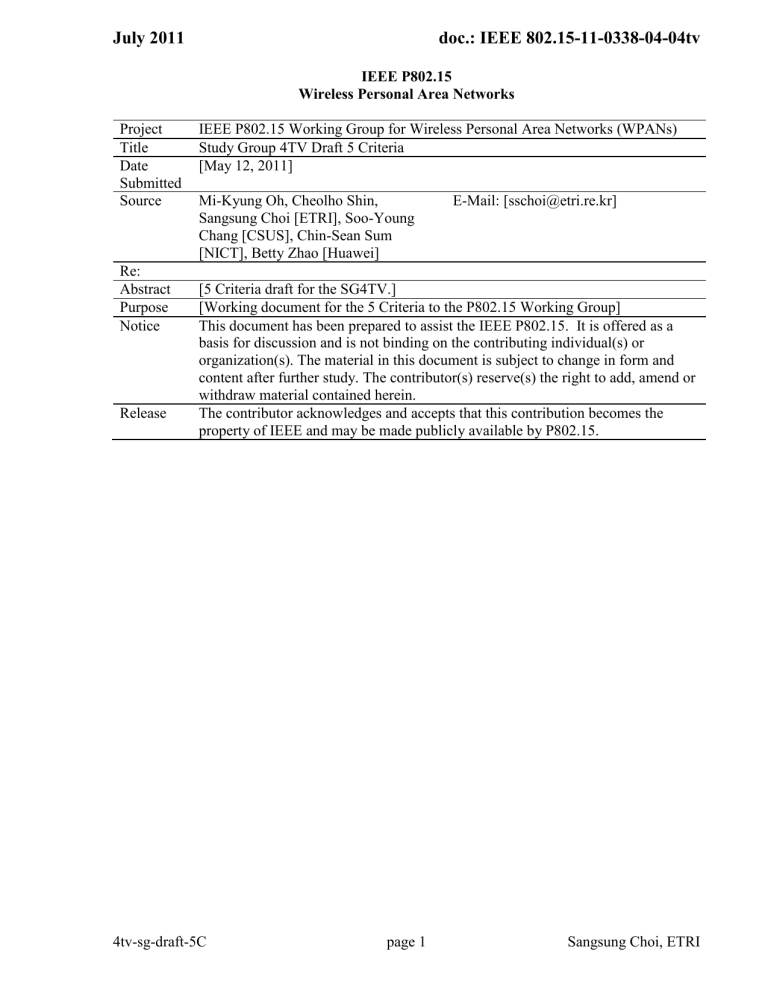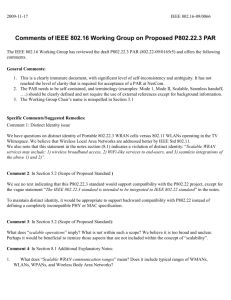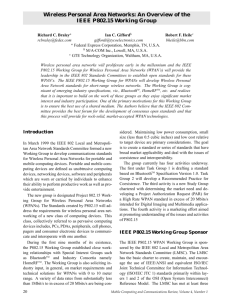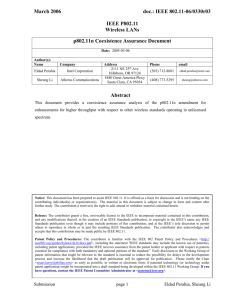doc. - IEEE 802 LAN/MAN Standards Committee

July 2011 doc.: IEEE 802.15-11-0338-04-04tv
IEEE P802.15
Wireless Personal Area Networks
IEEE P802.15 Working Group for Wireless Personal Area Networks (WPANs) Project
Title
Date
Submitted
Source
Study Group 4TV Draft 5 Criteria
[May 12, 2011]
Mi-Kyung Oh, Cheolho Shin,
Sangsung Choi [ETRI], Soo-Young
Chang [CSUS], Chin-Sean Sum
[NICT], Betty Zhao [Huawei]
Re:
Abstract [5 Criteria draft for the SG4TV.]
E-Mail: [sschoi@etri.re.kr]
Purpose [Working document for the 5 Criteria to the P802.15 Working Group]
Notice This document has been prepared to assist the IEEE P802.15. It is offered as a basis for discussion and is not binding on the contributing individual(s) or organization(s). The material in this document is subject to change in form and content after further study. The contributor(s) reserve(s) the right to add, amend or withdraw material contained herein.
Release The contributor acknowledges and accepts that this contribution becomes the property of IEEE and may be made publicly available by P802.15.
4tv-sg-draft-5C page 1 Sangsung Choi, ETRI
July 2011 doc.: IEEE 802.15-11-0338-04-04tv
5 Criteria- 802.15 SG4TV, Amendment to 802.15.4 current revision
1. Broad Market Potential
a) Broad sets of applicability.
There are many existing 802.15.4 based low data rate command and control applications, such as outdoor infrastructure management and control, that can benefit from the advantages offered by a TV White Space Physical Layer, particularly better coverage and range with less infrastructure.
b) Multiple vendors and numerous users
There are many vendors and users of IEEE 802.15.4 wireless equipment for indoor and outdoor operation. It is expected that there will be several existing as well as several new vendors offering equipment for this band as an extension to their existing portfolio of products.
c) Balanced costs (LAN versus attached stations)
Based on known implementations of other TV White Space devices, the proposed amendment can be implemented with connectivity costs which are reasonably small as compared to the cost of devices or the value of the applications served even if there is an added cost burden of required elements needed to operate in TV White Spaces. Focusing on low data rate helps in lowering the overall cost of implementation and is the motivation for developing an optimized solution.
2. Compatibility
IEEE 802 defines a family of standards. All standards shall be in conformance with the IEEE
802.1 Architecture, Management, and Interworking documents as follows: 802 Overview and
Architecture, 802.1D, 802.1Q, and parts of 802.1f. If any variances in conformance emerge, they shall be thoroughly disclosed and reviewed with 802.1.
Each standard in the IEEE 802 family of standards shall include a definition of managed objects which are compatible with systems management standards.
This standard will be compatible with the IEEE 802 requirements of Architecture,
Management, and Inter-networking documents as required. There is no specific technology feature anticipated in the standard that could preclude this compliance.
3. Distinct Identity a) Substantially different from other IEEE 802 standards
There are no other IEEE 802 projects, utilizing unused TV channels, specifically addressing low data rate operation optimized for use in device command and control applications.
b) One unique solution per problem (not two solutions to a problem)
An optimized wireless solution specifically designed for command and control applications has not been anticipated by any other wireless standard where the focus has been on delivering effective broadband capability. Consequently, this is the only optimized solution to this particular problem.
c) Easy for the document reader to select the relevant specification
4tv-sg-draft-5C page 2 Sangsung Choi, ETRI
July 2011 doc.: IEEE 802.15-11-0338-04-04tv
The proposed standard will produce an amendemnt to the IEEE 802.15.4 specification.
4. Technical Feasibility
a) Demonstrated system feasibility
The use of TV White space with prototype equipment complying with proposed regulations
(e.g. FCC rules) has been demonstrated and well documented.
b) Proven technology, reasonable testing
The use of TV White Spaces for Data Communications has been well proven both by laboratory testing and market deployments. In terms of technical feasibility, the Command and Control application presents no new challenges.
c) Confidence in reliability
Previously demonstrated applications of the technology provide confidence in the reliability of the proposed project.
d) Coexistence of 802 wireless standards specifying devices for unlicensed operation
The WG will create a coexistence assurance document as a part of the WG balloting process.
5. Economic Feasibility
a) Known cost factors, reliable data
The fundamental radio technology and associated cost of implementation is well established.
b) Reasonable cost for performance
Based on performance and related costs of existing 802.15 low data rate systems, a TV White
Space implementation will meet the expectations even if there is an added cost burden of required elements needed to operate in TV White Spaces. Focusing on low data rate helps in lowering the overall cost of implementation and meeting spectral mask rquirements.
c) Consideration of installation costs
The TV white space enabled 802.15 devices will have no impact on individual device installation costs and will likely reduce over system level implemention costs based on the reduction in required infrastructure.
4tv-sg-draft-5C page 3 Sangsung Choi, ETRI









